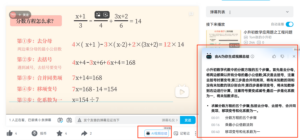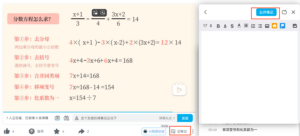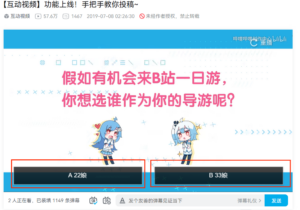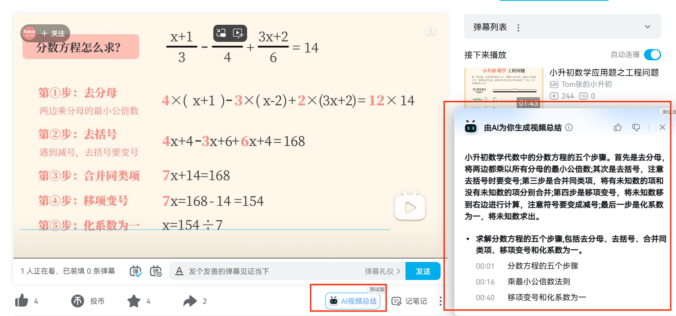Learning Design II – gregvanhorne (opened.ca)
Month: June 2024
【Fractional Equations in Mathematical Algebra for Junior High School Students】 https://www.bilibili.com/video/BV1UE421P7FC/?share_source=copy_web&vd_source=007e3c80fe9d934af0a959580c5c5d44
This video is from a Chinese video website called bilibili, which mainly explains in detail how to calculate an algebraic equation. This video itself lacks interactive content and is mainly explained by traditional teachers. So this video also does not require learners to make fixed responses. Compared to classroom teaching, but in terms of this video, the interactivity is almost zero.
After watching this video, learners are more likely to follow the problem-solving approach in their calculations because the content does not explain the theorem. In this situation, learners cannot engage in reflection, but can only be provided with examples. But the functionality of this video website itself allows learners to engage in further activities.

In this picture, it can be seen that the video website has built-in AI analysis of video content. Although it is not perfect, it can provide a simple overview. For example, in the pop-up window on the right, the steps required for calculating algebraic equations are introduced. Learners can directly obtain concise text to assist in understanding video content.

In addition, the website also has a simple note taking function. Not only can a video image be inserted, but it can also provide the video time where the image is located. At the same time, this note also has a sharing function, where learners can directly send their notes to the comments section, so that other learners can also understand the other person’s thoughts and learning situation. Similarly, teachers can also receive feedback through these notes.

This video does not have this feature, but Bilibili’s video format can be set as an interactive video. As shown in the figure, after playing a video, the audience can make choices, and different choices will continue to play different videos. This means that I can create an exercise video for learners to make choices. The correct choice will receive the correct answer, while the wrong choice can be given an explanatory video.
This type of learning through video is much easier compared to meetings on Zoom, and it is also more convenient for students to share and receive responses. Some learners may not be good at direct communication with others, and sharing notes can compensate for the evaluation and reflection between learners.
In inclusive learning design, universal design is essential as it can better benefit learners. As the core principle of universal design goes, “What is essential for some is always good for all.” These inclusive designs not only help individual or partial learners, but sometimes also provide convenience for the remaining learners.
How to meet the needs of learners
In my interactive learning resources, the purpose is to enable learners to understand the distributive properties in algebra and to utilize them to solve real-world problems. In order to make it easier for learners to understand, the first step is to explain the distributive properties in algebra and provide examples. Through practical examples, it is easier for learners to understand than just giving a speech. At the same time, practice after explanation is necessary to enhance learners’ understanding and impression of knowledge in memory. Secondly, in order to enable learners to solve problems using the distributive properties in algebra, some simple real-world problems are also necessary. But before that, practical examples are also needed to help them understand. In the example, real-world problems are transformed into simple formulas through steps, allowing learners to use this approach to solve problems.
Through these methods, I will try my best to help learners understand distributed properties in Algeria and the problem-solving approach. Meanwhile, these issues will also be presented in the form of group assignments. In group work, learners can quickly receive feedback and make corrections accordingly.
Handling of unexpected situations
In case of unexpected situations, such as the need for online teaching for certain reasons, I believe that simple webpage links and collection tables are a choice. By using web links in the form of text and images, learners can be informed of the content in a concise manner. At the same time, some online learning may choose different teaching websites or software for video conferencing, but this often brings confusion to learners and prevents them from learning in a timely manner. So simple webpage links can save a lot of trouble. The reading function of web pages also facilitates learners to understand the content.
Collecting tables is also for the same purpose. Setting questions on different websites can easily confuse learners, and sometimes educators may not be able to understand the system, which can lead to errors.
In this week’s reading, the first thing I understood was the first principles of instruction. The first principle is more about motivating students to learn and giving them motivation to learn in order to make teaching more efficient. Using the First Principles of Instruction to Make Instruction Effective, Efficient, and Engaging (edtechbooks.org)In this article, the author proposes that motivation is not the first principle, but rather the result. Motivation is the process by which students are motivated to learn and subsequently develop interest, making them more motivated to engage in learning.
Typical Instruction
In typical instruction, the teaching sequence mainly consists of three steps. Firstly, teach a topic, then insert exercises or quizzes, and finally have an exam or project at the end of the term. This approach has been reflected in most of the courses I have studied, but it does not appeal well to students. Although this process can quickly enable students to learn skills or solve problems. The characteristics of this educational model share many similarities with the behaviorist educational philosophy.
The Five Basic Principles of the First Principle
There are five different general principles for the first principle, which are Activation, Demonstration, Application, Integration, Problem-centered。
Activation represents that if students use existing knowledge as the foundation for new knowledge, learning will be promoted. This part is reflected in many courses, for example, many courses in economics recommend having a foundation in economics.
Demonstration represents that when students observe demonstrations of learning knowledge, learning can be promoted. This section suggests that teachers present more knowledge demonstrations rather than complete presentations.
Application encourages learners to apply newly acquired knowledge and skills. Generally speaking, many courses have this section, such as exercises and tests after the course ends.
Integration is the process of sharing and reflecting on the work of peers through collaboration and mutual criticism. This part is reflected in the EDCI335 course, where members of the group share the content they have read with each other and provide comments.
Problem centered strategies, which focus on student engagement, can facilitate learning. Because the ultimate goal of most teaching is to solve complex problems in reality. The subsequent skills learned in problem-solving can help learners better solve problems.
Curriculum and Five General Principles
In our course, several of these five basic principles are covered, while the others are not.
For example, Application and Integration have a significant proportion in our course, but this part is often missing in other courses, especially Integration. In group learning, we can more easily receive direct feedback and comparison.
However, Activation is missing in our course, which means we do not have prior knowledge when reading some materials. This often leads to differences in understanding some content.
